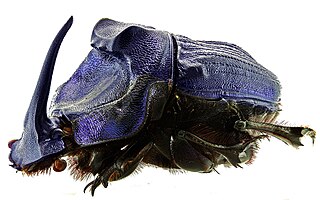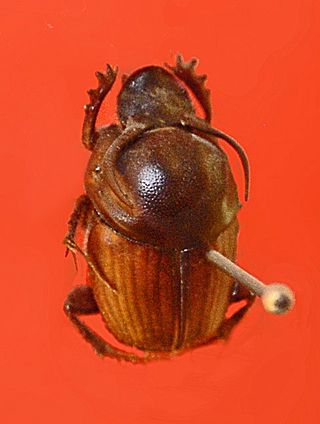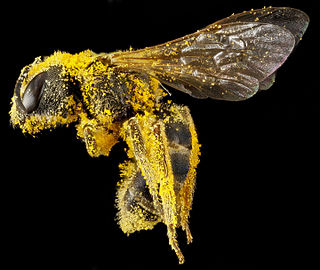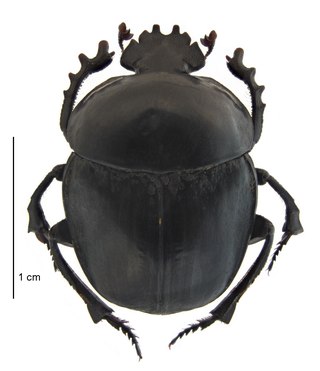
Dung beetles are beetles that feed on feces. Some species of dung beetles can bury dung 250 times their own mass in one night.

The scarab beetle subfamily Scarabaeinae consists of species collectively called true dung beetles. Most of the beetles of this subfamily feed exclusively on dung. However, some may feed on decomposing matter including carrion, decaying fruits and fungi. Dung beetles can be placed into three structural guilds based on their method of dung processing namely rollers (telecoprids), dwellers (endocoprids) and tunnelers (paracoprids). Dung removal and burial by dung beetles result in ecological benefits such as soil aeration and fertilization; improved nutrient cycling and uptake by plants, increase in Pasture quality, biological control of pest flies and intestinal parasites and secondary seed dispersal. Well-known members include the genera Scarabaeus and Sisyphus, and Phanaeus vindex.

Nicrophorus quadripunctatus is a species of burying beetle that predominates in East Asia. First described by German entomologist Ernst Kraatz in 1877, this beetle has since been the subject of much scientific inquiry—particularly concerning its parental care. Like other burying beetles, N. quadripunctatus inhabit small, vertebrate animal carcasses. This environment provides the beetles with the requisite nutrients for themselves and their offspring. To limit resource theft and predation, the carcass is buried underground. For additional protection, a single, dominant male-female pair guards the carcass cooperatively.

Scathophaga stercoraria, commonly known as the yellow dung fly or the golden dung fly, is one of the most familiar and abundant flies in many parts of the Northern Hemisphere. As its common name suggests, it is often found on the feces of large mammals, such as horses, cattle, sheep, deer, and wild boar, where it goes to breed. The distribution of S. stercoraria is likely influenced by human agriculture, especially in northern Europe and North America. The Scathophaga are integral in the animal kingdom due to their role in the natural decomposition of dung in fields. They are also very important in the scientific world due to their short life cycles and susceptibility to experimental manipulations; thus, they have contributed significant knowledge about animal behavior.

Coccotrypes dactyliperda, the date stone beetle, palm seed borer, or button beetle, is an insect belonging to the subfamily bark beetles (Scolytinae). It originates from Africa and is spread around the world due to the trading and transportation route.
Cephalodesmius is a genus of Scarabaeidae or scarab beetles.

Coprophanaeus is a genus in the family Scarabaeidae. The genus is almost entirely Neotropical, with a single species, C. pluto, ranging into southernmost Texas in the United States. They are medium-sized to large beetles, with the South American C. ensifer and C. lancifer sometimes exceeding 5 cm (2 in) in length, making these two some of the largest dung beetles in the world and the largest in the Americas. They often have a horn on the head, and are typically a bright metallic color, most often blue or green, or black. These diurnal or crepuscular beetles are excellent diggers and good fliers.
Filial cannibalism occurs when an adult individual of a species consumes all or part of the young of its own species or immediate offspring. Filial cannibalism occurs in many species ranging from mammals to insects, and is especially prevalent in various types of fish species with males that engage in egg guardianship. The exact evolutionary purpose of the practice in those species is unclear and debated among zoologists, though there is consensus that it may have, or may have had at some point in species' evolutionary history, certain evolutionary and ecological implications.

Bolitotherus cornutus is a North American species of darkling beetle known as the horned fungus beetle or forked fungus beetle. All of its life stages are associated with the fruiting bodies of a wood-decaying shelf fungus, commonly Ganoderma applanatum, Ganoderma tsugae, and Ganoderma lucidum.

Onthophagus taurus, the taurus scarab, is a species of dung beetle in the genus Onthophagus and the family Scarabaeidae. Also known as the bull-headed dung beetle, it is a species that specializes in cattle dung and is widely utilized to maintain clean pastures, making it agriculturally valuable. These beetles are typically 8–10 millimetres (0.31–0.39 in) in size. The males of this species exhibit distinct characteristics: large “major” males possess long, sweeping, curved horns resembling those of a longhorn bull, while small “minor” males have tiny horns that project upward from the back of their heads. Females, on the other hand, lack horns. These small beetles are oval shaped, the color is usually black or reddish brown. Sometimes the pronotum has a weak metallic sheen.

Halictus ligatus is a species of sweat bee from the family Halictidae, among the species that mine or burrow into the ground to create their nests. H. ligatus, like Lasioglossum zephyrus, is a primitively eusocial bee species, in which aggression is one of the most influential behaviors for establishing hierarchy within the colony, and H. ligatus exhibits both reproductive division of labor and overlapping generations.

Sceliages, Westwood,, is a sub-genus of the Scarabaeus dung beetles, and are obligate predators of spirostreptid, spirobolid and julid millipedes, having renounced the coprophagy for which they were named. The genus is near-endemic to Southern Africa, Sceliages augias exceptionally ranging as far north as the Democratic Republic of Congo.

Coprophanaeus ensifer is a large South American species of beetle belonging to the family Scarabaeidae. This species is necrophagous and builds burrows near or on animal carcasses to dismember the flesh of decaying bodies and bring it to its burrow to feed. Both females and males help build the burrow and feed. It is characterized by its iridescent colors and a horn that is similar in shape and size in females and males. It uses its horn to tear apart carcasses and to fight with other individuals, with male-male fighting occurring more often. However, females also fight to determine a variety of characteristics of the opposing male. This species may be of importance in forensic science due to its destructive behavior on decaying bodies, especially in areas of Brazil where homicide rates are high.

Phanaeus, the rainbow scarabs, is a genus of true dung beetles in the family Scarabaeidae, ranging from the United States to northern Argentina, with the highest species richness in Mexico. Depending on species, they can inhabit a wide range of habitats, from tropical to temperate climates and deserts to rainforests. In those living in relatively arid places adults are primarily active during the wet season and those living in relatively cold places are primarily active during the summer. They are excellent diggers and good fliers.

Sulcophanaeus imperator is a brightly colored species of dung beetle belonging to the family Scarabaeidae. This diurnal, coprophagous beetle is native to south-central South America and generally common. It is paracoprid, meaning that adults dig tunnels into the soil under the food source and move parts of the food source to a nest chamber where the eggs are laid.

Phanaeini is a tribe of dung beetles in the family Scarabaeidae. There are about 12 genera and 200 described species in Phanaeini. They are native to the Americas with the highest species richness in the Neotropics. They are mostly coprophagous or necrophagous, but some of the least known genera appear to be myrmecophilous. They are medium-sized to large beetles, often with bright metallic colors, and often with horns on their heads.

Euoniticellus intermedius is a species of dung beetle in the family Scarabaeidae. E. intermedius is native to Southeastern Africa but has spread to the United States, Mexico, and Australia. E. intermedius acts as an important agricultural agent due to its improvement of soil quality and removal of parasitic pests.

Coprophanaeus lancifer is a large species of beetle belonging to the family Scarabaeidae.

The white worm beetle is a species of beetle in the family Scarabaeidae. It is the only species in the genus Hylamorpha. This beetle is native to South America, particularly in regions of Argentina, Brazil, and Uruguay.

Thorectes lusitanicus is a medium-sized dung beetle ranging from 30-175 mg in dry body weight. It is flightless with strong mandibles that allow it to exploit dry dung. It is native to the southern Iberian Peninsula. It is a tunneller that builds shallow tunnels several meters from the site of a dung deposition and transports the dung into the tunnel. Once the dung is in the tunnel, females of this species lay their eggs within it.



















